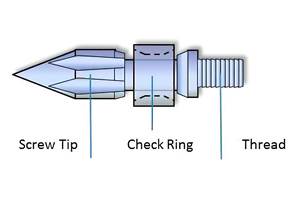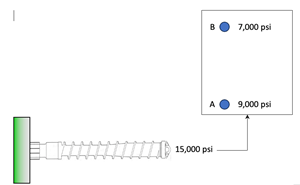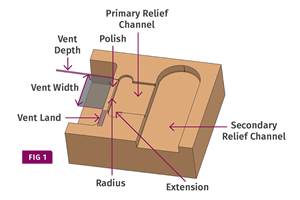Do High-Temperature Resins Require a Specialty Screw?
Learn how applying a “reverse” temperature profile, where the barrel temperatures are higher in the rear and lower at the discharge end, can help keep high-temp resins moving in the barrel.
Q. I recently won a job and am running a resin I have never processed before. It is a high-temperature PPS. But the screw does not seem to be conveying the material forward. What could be the problem? Do I need a new screw or can some other process adjustment help me?—Chicago-area molder
A. Most likely your screw is “wind-milling,” meaning it isn’t picking up the material. This phenomenon is due to poor solids conveying. Solids conveying occurs when the material “sticks” to the barrel and “slips” on the screw. This is necessary to move the material forward.
Most often this problem is exhibited when processing high-temperature engineering resins, including the one you noted. Normally, if you make an adjustment to your barrel-temperature profile, your existing screw design will work fine. Change the temperature profile from a commonly used “flat” profile to a “reverse” temperature profile, where the barrel temperatures are higher in the rear and lower at the discharge end. For instance, if your present profile, starting at the feed zone of the screw, is 450, 450, 450, and 450 F, change it to 500, 480, 460, and 440 F. Some processors believe that the higher temperatures in the rear zones will increase their melt temperature. Not so. Remember that the plastic is still in pellet form in the feed section, so this recommended change won’t influence melt temperature. But it will improve the coefficient of friction at the barrel wall between the pellets and barrel and therefore improve the solids conveying and eliminate the “wind-milling” effect.
Timothy Womer, Global Corporate Technical Advisor
Xaloy Inc., New Castle, PA
(800) 897-2830
Q. Quite often, especially during the summer, the nylon we’re running does not seem to get dry enough to prevent occasional quality problems. What can we do to get the material dryer?—Humid in Houston
A. Drying is a complicated process, and there could be many reasons why your material is not drying, but here are a few things you should look at. First, I’ll assume you are following the resin maker’s drying recommendation for dewpoint, temperature, and air flow, and that your dryer is properly maintained—no air leaks or clogged filters. If you have enough capacity in the dryer itself, it may be that your hopper is undersized for your throughput. Especially when the ambient air is quite humid, nylon needs as much as 6 hr of drying time. If you are running 100 lb/hr but your hopper has only 500 lb capacity, there is no way to get adequate drying time. You may need a larger drying hopper, or perhaps you can simply add an extension on top of your existing hopper to give you the added capacity. If you only run nylon part of the time and you don’t need the larger hopper for other materials, consider using a spare dryer and hopper to predry the nylon for a couple of hours before you convey it to the primary dryer. Running the two dryers in tandem can give you added residence time in a pinch.
Doug Brewster, national sales manager,
The Conair Group, Cranberry Township
(724) 584-5500
Related Content
Got Streaks or Black Specs? Here’s How to Find and Fix Them
Determining the source of streaking or contamination in your molded parts is a critical step in perfecting your purging procedures ultimately saving you time and money.
Read MoreUnderstanding the Effect of Pressure Losses on Injection Molded Parts
The compressibility of plastics as a class of materials means the pressure punched into the machine control and the pressure the melt experiences at the end of fill within the mold will be very different. What does this difference mean for process consistency and part quality?
Read MoreA Systematic Approach to Process Development
The path to a no-baby-sitting injection molding process is paved with data and can be found by following certain steps.
Read MoreBack to Basics on Mold Venting (Part 2: Shape, Dimensions, Details)
Here’s how to get the most out of your stationary mold vents.
Read MoreRead Next
People 4.0 – How to Get Buy-In from Your Staff for Industry 4.0 Systems
Implementing a production monitoring system as the foundation of a ‘smart factory’ is about integrating people with new technology as much as it is about integrating machines and computers. Here are tips from a company that has gone through the process.
Read MoreLead the Conversation, Change the Conversation
Coverage of single-use plastics can be both misleading and demoralizing. Here are 10 tips for changing the perception of the plastics industry at your company and in your community.
Read More









